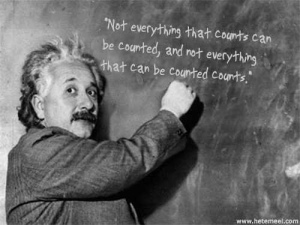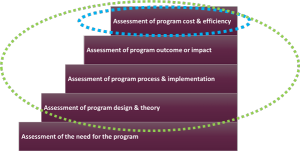The world of program evaluation, like any other, has its hot topics. Multi-methods evaluation, developmental evaluation and data visualization are a few of the things evaluators have been buzzing about recently. At the 2014 annual Canadian Evaluation Society conference in Ottawa, Social Return on Investment (SROI) splashed onto the evaluation scene in Canada with three interesting and diverse presentations on the topic. More about that later.
First, for those not familiar with it: What is SROI? The international SROI Network defines SROI as “…an approach to understanding and managing the value of the social, economic and environmental outcomes created by an activity or an organization.” It is a principles-based approach that seeks to reflect the net social, economic and/or environmental value for stakeholders and change that is often not valued or described in monetary terms.
The international SROI Network further highlights that the approach aims to give participants a voice in resource allocation decisions and that it is “a story and not a number.” This is a reference to something that stands out the first time you read an SROI report: the SROI ratio, which describes the net social, economic and/or environmental return for every dollar invested in the program in financial terms (e.g. an SROI ratio of 3.14:1 indicates a $3.14 social return for every $1 invested in the program).
So where does SROI fit into the larger evaluation world and what does it add? What makes it unique and when is it best used? As an evaluator, I see SROI as a tool that can help me, the program staff, participants and funders to understand program cost, efficiency, and effectiveness in terms of value. I think this goes broader than the Rossi et al. conceptualization of the assessment of program cost and efficiency, because it includes an analysis of the financial and in kind input, as well as the value created and consumed for various stakeholders that experience change due to the program. If you are an evaluator thinking of using the SROI methodology, the good news is that the front end of an SROI analysis is an outcome-based evaluation.
Scoping, identifying key stakeholders, clarifying the program’s theory of change, and mapping and measuring outcomes for each program activity are all standard parts of an SROI analysis. Some of SROI’s unique attributes are that:
- It goes further to research and assign financial proxies for those outcomes that allow for it
- It typically takes a broader look at outcomes for various target stakeholders and not just the program’s target participants (e.g. funders, communities, siblings and parents of target participants and public services)
- It advocates for and applies a built in, standardized process of differentiating between outcomes and impact by calculating discount rate, attribution, deadweight, drop-off and displacement to ensure a defensible SROI is calculated (avoiding over-claiming of the social return)
- It tells the story of change for stakeholders, using both qualitative and quantitative change descriptions from the outcome-based evaluation as well as a description, in financial terms, of the net value created for stakeholders (this is the SROI ratio)
The three SROI sessions at the evaluation conference mentioned at the beginning of this article provide a good snapshot of where SROI is currently surfacing in the Canadian evaluation landscape. The presentations were about: (i) three evaluator’s experiences conducting an SROI analysis for the first time; (ii) an emerging meta-analysis of 150 SROI reports; and (iii) an introduction to SROI for evaluators by a leading Canadian practitioner. SROI is most definitely being discussed, considered and utilized by Canadian evaluators and program staff. It is also reaching a level of maturity and exposure where robust discussions can be had about the appropriate use of and assumptions behind the methodology.
Through various networks and within multiple private, public and non-profit organizations, the community of SROI practitioners and users are growing, leading to a growing body of knowledge and work that informs SROI practice.
SROI has come into my sparse ‘assessment of program cost & efficiency’ toolbox at an opportune time as I have become more aware of and involved in social change, partnership and entrepreneurship initiatives. The SROI methodology is providing this evaluator with a flexible but grounded approach to help program staff, participants and funders measure, understand and talk about social change.
For more information on the methodology and to get involved in the social value measurement conversation, visit:
http://www.sroi-canada.ca/
http://www.thesroinetwork.org/
http://impactinvesting.marsdd.com/simt/social-return-on-investment-sroi/
http://www.siaassociation.org/
References:
The SROI Network. (2012). A guide to Social Return on Investment. (2nd ed.).
Rossi, P.H., Lipsey, M.W., & Freeman, H.E. (2004). Evaluation. A systematic approach. (7th ed.). Thousand Oaks: Sage
Jasper Buys joined SiMPACT Strategy Group in June of 2014 after a number of years focused on strategic planning and evaluation at Athabasca University. Jasper holds a Master of Social Sciences degree in Organizational Psychology from the University of Cape Town in South Africa. His focus at SiMPACT is in SROI and evaluation consulting for various federally, provincially and foundation funded programs and initiatives that aim to create positive social, economic and/or environmental impact. Jasper is a director of the Alberta and North West Territories Chapter of the Canadian Evaluation Society, a Rotarian and a self-appointed ambassador for the fine wines of South Africa. Jasper and his wife, Lecia, live in Calgary with their energetic Labrador puppy, Nelson.



